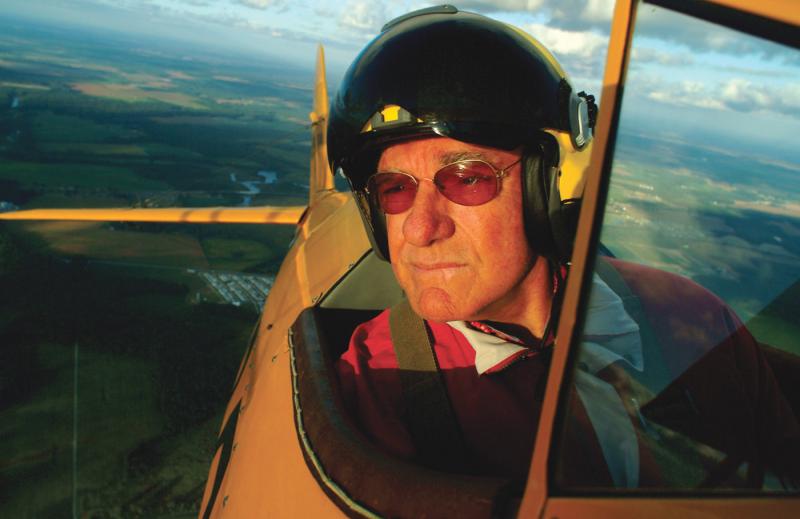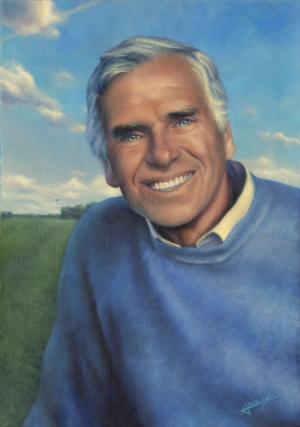Joe Hudson: A life of flying and friends
Growing up in Harbeson during the 1930s and ‘40s, Joe Hudson and his best friend Ted Freeman hung around the airport in Rehoboth. They washed planes, got jobs sweeping up, then traded more work for flying lessons.
In ninth grade, Joe took his first airplane ride in a J-3 Cub, and he continued to work delivering milk to the Georgetown Airport each morning at 4 a.m. Once the sun came up, he could watch the Navy trainers practice carrier landings and "snatch guys up off the ground by a hook."
The trainers flew over Delaware Bay from their home at Cape May County Naval Air Station in Wildwood, New Jersey. In 1943, the 23rd Carrier Aircraft Service Unit was stationed in Georgetown, so Joe was able to watch the Grumman TBF-1 Avenger, the Navy carrier-based torpedo bomber, practice its landings. And he watched the Curtiss 2B2C dive bomber practice bombing near the marshes northeast of the Georgetown Airport.
Joe and Ted also made time for football during the late 1940s at Lewes High School. Joe played tackle, and during a game against Rehoboth Beach, his front teeth were knocked out. Ted was hospitalized after another game and Joe said they were "really hurt by those Rehoboth boys." This was Lewes High School's first football team, and Joe played so well that he earned a football scholarship for college. But after a few months in North Carolina, he was offered a flying job back home, and he quickly left college and football behind.
As high school students, Joe and Ted were already flying and being paid to do it. They flew over Delaware Bay and along the Atlantic Coast in Stinson aircraft owned by Rehoboth Airport, looking for schools of menhaden fish.
Later their planes were owned by Lewes Mayor Otis Smith, who also ran his family's Fish Products company. Their task was to identify the blackish stains on the water's surface that indicated schools of menhaden, determine their direction of movement and inform the fishing boat captains below.
The Stinson aircraft of the late '40s were not yet equipped with radios, so Joe and Ted dropped sealed bottles or jars containing notes as to the menhaden location and direction of travel. That was called "fish spotting."
Up, up and away
By his senior year in high school, Joe had already earned his commercial pilot's license and used it to win a contract to spray mosquitos for the state. Joe also flew charter flights and continued fish spotting. He and Ted flew their boss, Otis Smith, to all his fisheries along the Atlantic, from New York to Florida. They may have been just "student fish spotters," but later pilots would have considered them "pioneer fish spotters." By the late '50s and early '60s, fish spotter pilots used radios to communicate with the fishing trawlers.
By then, both Joe and Ted were flying larger aircraft for different purposes.
As high school students, Joe and Ted were nominated for and accepted into the U.S. Naval Academy in Annapolis, Md. Ted attended, graduated, then left the Navy for the Air Force to become a fighter jet pilot.
He was one in the first group of designated astronauts selected for the NASA Gemini and Apollo programs. He was also one of the first to die in the line of duty. Near Ellington Air Force Base in Texas, his T-38 Talon jet fighter collided with a flock of snow geese. He crashed as he attempted to "dead-stick" onto the runway and avoid military housing nearby.
"He was always looking out for other people," said Joe.
The same has been said about Joe Hudson, who still becomes emotional when remembering his best friend.
In 1950, just after high school graduation, Joe began his own aerial application business with two WWll vintage aircraft.
He redesigned the Stearman biplanes originally used as Air Force trainers and outfitted them for spraying chemicals. By 1956 he owned and operated seven Stearman spray planes, and he hired other pilots and a ground man to mix chemicals and keep them flying. Joe was just 20, and he and his team worked from his private airstrip just north of Lewes.
About a year later, Joe traded his Stearmans for two twin-engine Beechcraft airplanes. The nozzles on the Stearmans continually leaked, covering the pilots, planes and ground crew with chemicals. His aerial application business was becoming more precise and needed to be much more efficient as well as safe.
Joe took what he had learned, then designed, built and installed new spray systems for both twin Beeches. He won FAA approval for his new spray systems. They were the first twin-engine spray planes in the East, and so effective that they replaced five of his seven Stearmans. He soon became one of the largest aerial applicators on the Delmarva Peninsula, and one of the first pioneers of the aerial spraying business.
Joe is probably best known locally as a boss, mentor and for many over the years, a friend.
A mentor and a friend
For Allen Chorman, Joe will always be thought of as a mentor and friend. "If it wasn't for Joe, I don't think I'd be sitting here right now," said Allen, reflecting on a long career as an ag pilot, including years of flying for Joe.
As a 10-year-old, Allen went to work for Joe washing planes at Rehoboth Airport and carrying irrigation pipe on Hudson's farm. During the mid '60s, Joe hired Allen to fly one of the Stearmans, then later hired his brother Ronnie.
Allen was Joe's chief pilot for 21 years, later flying one of the two twin Beeches. In 1987, Allen started his own business and bought out his longtime boss, mentor and friend. Together they share places in the Delaware Aviation Hall of Fame, along with another "newcomer" ag pilot and former Hudson employee, Jimmy Vreeland. These guys are now retired and to this day are still the best of friends.
Reporter Andy Cline named Joe the "crop spraying pioneer" in 1978, after watching him work a field of wheat. Andy wrote about how the "sleek racy craft banked steeply then zoomed inches from the crop expelling the load."
After each pass, he said, the plane appeared to "float for a moment" as it turned to make another pass. It would disappear behind the trees, reappear, engine roaring, skimming the tree line, and drop quickly to the wheat after dodging power lines. Then it was gone and quiet.
Andy watched as the "duster" headed west for home, disappearing into the pink dust. Flying into the darkening blue-pink twilight, was Joe really thinking "another field with a higher yield because of aerial applications?" Maybe.
He did love to fly, but he also did so much good for so many people.
During his agriculture and flying career, Joe - as a member and president of the hospital board of directors - helped Beebe Medical Center add facilities including a wing in 2008 named in his honor and a helipad for incoming medevac helicopters.
In 2014, Joe donated his beloved Navion RangeMaster aircraft to the aviation powerplant program at Delaware Technical Community College. The airframe and powerplant facility located at Sussex County's Delaware Coastal Airport is now home for the Theodore C. Freeman Powerplant Education Building, dedicated in 2014 and named after Joe's friend. Joe's wish is that his donated Navion will help the college graduate more students as airframe and powerplant technicians.
Joe Hudson will always be a farmer, aviator, business entrepreneur, humanitarian, philanthropist, developer, and dean of Delaware crop dusters. What would he say to high school students today: "Learn to fly. The No. 1 thing is to be good at business, and then make money and make people happy."
He has indeed, and his flying friends would agree.






















































